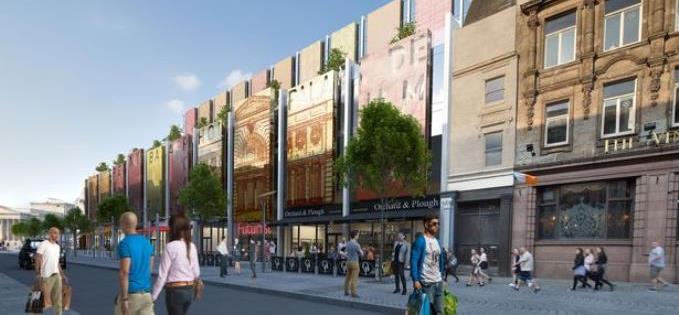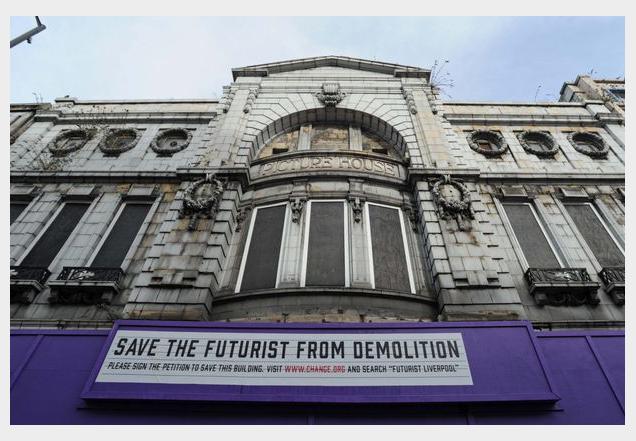THE Futurist saga has continued with campaign group SAVE Britain’s Heritage saying it has won a key victory at the Court of Appeal in the fight to save the frontage of the 1912 Lime Street cinema immediate demolition.
SAVE said Liverpool City Council had previously told the court that the front elevation was in danger of imminent collapse and posed a safety risk. It added that on May 6 the council gave undertakings to deconstruct the minimum necessary and to mark up and store the removed materials so that the façade could be reconstructed.
A week later the council said the façade could not be dismantled by hand and would have to be partially demolished with heavy plant.
This, claimed SAVE, would potentially leave only the ground floor standing with no prospect of the Futurist’s reconstruction if SAVE was successful in its wider appeal. The scaffolding around the Futurist was removed last Saturday in preparation for immediate demolition works.
At a Court of Appeal hearing on Monday, SAVE’s barrister, Richard Harwood QC, supported by specialist construction engineer Ed Morton of The Morton Partnership, successfully argued that there were alternative means of safeguarding the frontage.
 Saving face: Hologram-style images of the demolished Futurist would be projected onto the new Lime Street development
Saving face: Hologram-style images of the demolished Futurist would be projected onto the new Lime Street developmentA SAVE spokeswoman said: “Lord Justice Lindblom was not persuaded that there was an imminent risk to public safety and accepted our argument that demolition in the manner proposed by the council risked triggering a collapse of the whole façade and surrounding buildings, and found that no safety or risk assessment was submitted to support their proposed emergency works.”
The campaign group said the judge also accepted the alternative scheme for stabilising the façade set out by Ed Morton using scaffolding and any necessary manual deconstruction of the unsafe elements of the Futurist was a cogent engineering solution which could be carried out in a safe manner to address the Council’s public safety concerns.
“This showed that the demolition as set out by the council was not necessary," said SAVE.
This latest decision is separate to the substantive Court of Appeal hearing regarding the planning permission for the redevelopment of the whole site on Lime Street. This is due to take place over the next six weeks.
Henrietta Billings, director of SAVE said: “This is a major step forward – we are delighted that the Court was persuaded by our arguments for the stabilisation of the main elevation, and that the imminent demolition has been halted. We are looking forward to assisting the Council with implementing the approach set out by Ed Morton to retain and stabilise the façade of this historic building.”
 Construction engineers Ed Morton convinced the Court of Appeal that immediate demolition of the top of the facade was not the only way forward, but the battle between Liverpool City Council and heritage campaigners SAVE goes on
Construction engineers Ed Morton convinced the Court of Appeal that immediate demolition of the top of the facade was not the only way forward, but the battle between Liverpool City Council and heritage campaigners SAVE goes onMarcus Binney, executive president of SAVE, said: “Cinemas were one of the 20th century’s most exciting new art forms and the Futurist is one of Britain’s earliest and grandest examples.”
The planning permission includes the loss of the Futurist cinema and over ten flanking historic buildings, and the redevelopment by developers Neptune of the site with an 11 storey student housing block.
A council spokesman told Liverpool Confidential: “Public safety is our absolute top priority and we are doing everything we can to make the façade of the Futurist safe as quickly as possible. An application by SAVE to the Court of Appeal on 6th May to have the safety work halted was dismissed after the judge heard our evidence about the fragile condition of the frontage.
"The judge accepted that public safety had to be our paramount concern and agreed with us that there was an imminent risk to the building. Urgent works are necessary and we are now considering how best to protect public safety whilst complying with our commitment to carry out the minimal works necessary, whilst preserving the materials where possible”.















